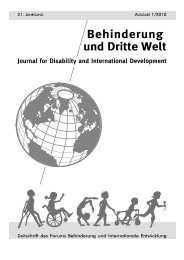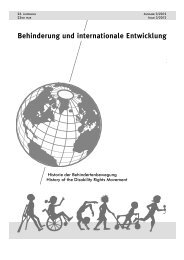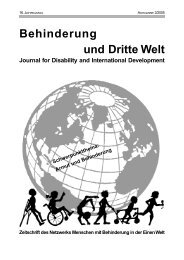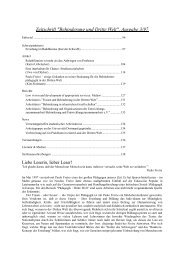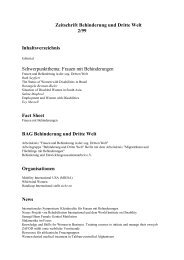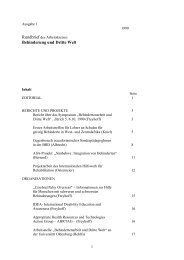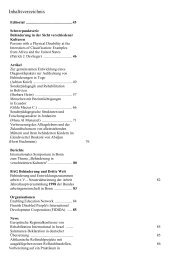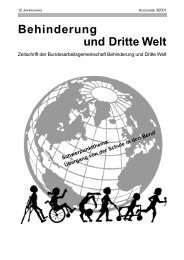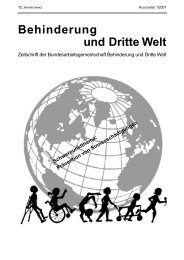Zeitschrift Behinderung und Dritte Welt
Zeitschrift Behinderung und Dritte Welt
Zeitschrift Behinderung und Dritte Welt
Create successful ePaper yourself
Turn your PDF publications into a flip-book with our unique Google optimized e-Paper software.
S CHWERPUNKTTHEMAtions. It is also a high level of international attention,commitment and collaboration whichcan act as an impetus for research. Attention tothe needs and rights of women with disabilities,however, has been noticeably absent in internationalhuman rights instruments until very recently.This is part as a result of limited attentionto the needs and rights of all people withdisabilities – and also the gender and the disabilitymovement’s tendency to overlook thoseindividuals whose needs fell in the very nexusof these two movements.International attention to the rights ofwomen as part of the international gendermovement gained attention before attentionwas focused on the rights of those with disabilities.The rights of women were first formally includedin a UN Convention on the Eliminationof Discrimination against Women (CEDAW)which was adopted by the United Nations GeneralAssembly in 1979 and put into practice inSeptember 1981. While CEDAW marked a majorachievement, there was no mention ofwomen with disabilities. Further, while the UniversalDeclaration of Human Rights – and theirtwo instruments: the Covenant on Economic,Social and Cultural Rights (ICESCR) and its twinthe Covenant on Civil and Political Rights – addressthe human rights of all people worldwidethey did not make specific reference to personswith disabilities. It was not until the Conventionon the Rights of the Child (CRC) that the rightsof children with disabilities were specificallymentioned in a UN Convention (Article 23).In 1985, only a couple of years after the ratificationof CEDAW and less than 25 years ago,in the context of the third World Conference onWomen, held in Nairobi, was it that womenwith disabilities became more visible. This was,in large part, due to the efforts of women activistsworldwide with disabilities themselves. Theyinsisted in being present and participating inthe conference to ensure that their voices wereheard. While the location of the parallel NGOForum was not very accessible and many governmentaldelegates were more concerned withpolitical issues, activists such as Ruth Begunfrom Disabled Persons International (DPI) in theU.S., were able to convince governments to includetwo paragraphs on women with disabilitiesin the section of the Nairobi Forward-lookingStrategies for the Advancement of Womenon groups requiring special concern.In the above mentioned paper, women withphysical and mental disabilities were among the13 special groups of women listed in the Strategies,and taken together, they were consideredto be vulnerable (UN Enable Website). This importantachievement was followed in 1990 bythe International Labor Organization (ILO) Convention(No. 159) which has been the onlybinding international treaty – until the recentadvent of the CRPD – which specifically mentionswomen with disabilities. This key instrumentaddresses the instruments relates to theright to decent work of persons with disabilitiesand prohibits discrimination on the basis of disability.This achievement was then followed in 1991by the General Recommendation No. 18 madeto CEDAW which also mentions women withdisabilities, recommending that states parties“provide information on disabled women… andspecial measures taken to deal with their particularsituation, including special measures toensure that they have equal access” to varioussocial services and the opportunity to “participatein all areas of social and cultural life”.While the movements towards gender equalityand disability rights over time had beengaining strength and influence, as noted aboveeach was remiss particularly in the early phasesof their movements, to ensure that the lived experienceof individuals who faced discriminationon both fronts – as a result of gender anddisabilities – were protected and considered.These individuals, caught in the nexus of thesetwo movements were at risk of further discriminationas the groups that were thought to representthem – had left their needs and rightsbehind. Those committed to gender equity, byfailing to consider disability and those committedto disability equity, by failing to considergender – perhaps unknowingly and unwittinglyrendered girls and women with disabilities invisible(Rousso 2006).“…women with disabilities are invisibleboth among those promoting the rights ofperson with disabilities, and those promotinggender equality” (UN 2009).This pervasive double discrimination – ordouble jeopardy has promoted a lived experienceamong girls and women with disabilitiesof discrimination and exclusion. Having hadtheir human rights consistently ignored – bothby international policy and on-the-gro<strong>und</strong>, theirhealth and well-being as a result of denied opportunitieshas been impacted. The needs andrights of women with disabilities has gained attentionin recent years – in terms of policy andpractice – and some efforts have been made toprotect and promote their rights and needs. Ata policy level, CEDAW General Recommendationswere added subsequent to its adoption(1991) which specifically focus on the rightsand considerations of women with disabilities.36 <strong>Zeitschrift</strong> <strong>Behinderung</strong> <strong>und</strong> <strong>Dritte</strong> <strong>Welt</strong> 3/2009



